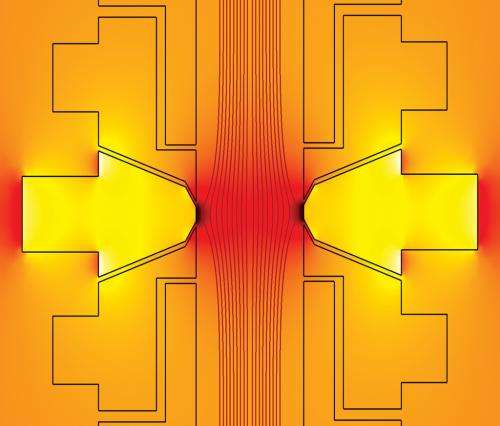A Penning trap with a ‘magnetic bottle’ magnetic field in which single protons can be captured for several months. The magnetic field lines of the trap are shown. Credit: 2013 Stefan Ulmer, RIKEN Ulmer Initiative Research Unit
One of the greatest mysteries of modern physics is the imbalance of matter and antimatter in the Universe. As every particle is produced and destroyed in tandem with its antiparticle, which has an identical mass but opposite charge, scientists are baffled as to why our Universe is matter dominated. In a significant advance that could allow direct measurement of the most minute differences between a particle and its antiparticle—and therefore potentially explain this imbalance—an international collaboration co-led by Stefan Ulmer from the RIKEN Ulmer Initiative Research Unit has developed a method that now makes it possible to observe reorientation of the magnetic moment associated with a single proton.
The secret as to why matter and antimatter are not found in equal proportions may lie in tiny but so far imperceptible differences between the properties of particles and their corresponding antiparticles. One of the properties of fundamental particles like protons that could be targeted for such a study is the magnetic moment, which orientates the particle in a magnetic field. In the most elementary case, magnetic moments have two options: 'up' or 'down'. The transition between these two states can be induced by radio waves, producing an observable effect that can then be measured. The research team used a Penning trap and a special 'magnetic bottle' field (Fig. 1) to capture individual protons and measure their spin properties.
"Similar effects can be caused, however, by other, much stronger mechanisms that have nothing to do with the transitions we are looking for," explains Ulmer. "We have now optimized our experimental setup and analysis methods to a point where we can unequivocally detect, for the first time, single flips of single protons."
The method allows the magnetic state of a proton to be determined reliably, and the researchers have already combined this with another technique that shuttles the proton to a second trap where its magnetic moment can be flipped with high accuracy—completing the requirements for a high-precision study.
This advance represents an essential move toward measuring the strength of the proton's magnetic moment with high precision. The next step is to develop the same measurement system for antiprotons produced by a particle accelerator, and the team is currently building a separate experimental system at CERN in Switzerland that will allow them to conduct such experiments.
More information: Mooser, A. et al. Resolution of single spin flips of a single proton. Physical Review Letters 110, 140405 (2013). dx.doi.org/10.1103/PhysRevLett.110.140405
Journal information: Physical Review Letters
Provided by RIKEN






















